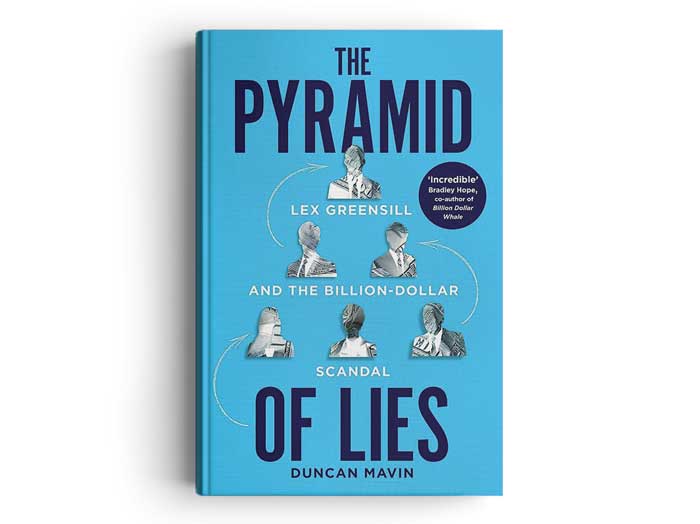
Dishonest truth: The rise and fall of a fintech house of cards
 In Pyramid of Lies, financial journalist Duncan Mavin dives as deeply into the financial world as into Lex Greensill himself (image provided)
In Pyramid of Lies, financial journalist Duncan Mavin dives as deeply into the financial world as into Lex Greensill himself (image provided)
There are lessons aplenty to be learned from The Pyramid of Lies: Lex Greensill and the Billion-Dollar Scandal, accountant and financial journalist Duncan Mavin’s riveting take on the rise and March 2021 fall of Lex Greensill’s “fintech” house of cards. Admittedly, most of those lessons inspire a degree of cynicism. Some are mild—the presumably well-lawyered author consistently and politely describes the most blatant contradiction of facts uttered by Greensill as “misleading.” Others are stark: small firms and individuals went bankrupt, while enablers the size of Japan’s massive SoftBank didn’t suffer much worse than a headache. More to the sharp point, Australian farmer’s son Greensill remains ensconced in his English manor, in full personal possession of millions of pounds—even if many have begun to evaporate in legal fees.
And that’s without focusing on the aspect of the scandal that most infuriated the British, the fortune Greensill paid former prime minister David Cameron for little more than opening doors from Japan to Saudi Arabia to (more ominously) the U.K. civil service. In February 2020, a year after Mavin first wrote about what was going on within Greensill Capital, the journalist met a source in a hotel café who passed him a book within a padded envelope. Later that day, someone broke into Mavin’s car, ignored brand-new gift purchases also present and stole that package. An unlikely coincidence, to put it mildly.
If those aspects of Pyramid are disturbing, the overall achievement is exhilarating it’s a superb history lesson. Mavin dives as deeply into the financial world that his ferociously ambitious protagonist encountered as into Greensill himself. The former, as it turns out, is far more interesting. After the 2008 financial crisis, in a seemingly endless low-interest environment that was not generating returns—or for financiers, fees—at previous levels, old-guard banking was in upheaval. There were some idealistic bankers interested in democratizing finance, and more looking for higher personal returns, as well as politicians seeking new and cheaper ways for smaller firms to borrow.
That made for a volatile, open-to-new-thinking, combination, especially when regulators—inevitably governed by rules and authority bound up with yesterday’s practices, not today’s innovations—were slow to adapt, Mavin writes. Fraudsters, on the other hand, are always among new tech’ s most enthusiastic early adopters. (A decade before Samuel Morse dispatched his famous first words by telegraph—“What hath God wrought.”—two French bankers in Bordeaux had already hacked into their government’s Paris-to-Bordeaux semaphore system to get insider information on stock exchange news.)
Cometh the hour, cometh the man, runs the old saying, and the financial world was in a perfect mood to listen to a smart, charismatic apostle for supply chain finance. SCF arose from factoring, a very old financing mode that let raw material suppliers secure payment from buyers—who hadn’t yet made their products and secured the funds to pay—via a middleman, a “factor” who bought the invoices at a discount and later recuperated it in full from the buyers. Technically, SCF is reverse factoring, through which buyers sell their debt rather than suppliers their credit. Either way, suppliers are paid more quickly, see their cash flow regularized and escape bullying from large buyers, who have been known to arbitrarily extend payment delays.
For governments, often their nations’ largest buyers (especially in health expenditures), bankers looking for new fee sources and investors seeking start-ups that offered potentially huge returns, it sounded good. Greensill’s problem was that SCF was never a huge money-maker, certainly not to the level that Greensill—who operated four company jets and owned luxury homes in Britain and Australia—desired or needed to entice major investors. So, he funded his pretend SCF business by using investors’ money to finance continually rolled-over short-term loans to the kind of client big banks recoil from, most notably Sanjeev Gupta’s murky assortment of iron-and steel firms.
For a while it worked like a charm: by late 2019 Greensill Capital was a unicorn, a start-up valued at over a billion dollars, and Lex Greensill himself had hundreds of millions. But when spooked insurers finally cut and ran 15 months later, pulling out one of the bottom-level cards from Greensill’s house, the entire structure collapsed.
Mavin displays extraordinary dedication to detail in this story of blind ambition and blind regulators, the revolving door between government and business, and a system where the big players never really lose even when what they backed turns to dust. And it all ends more with a whimper than a bang. Lawyers and accountants are still sifting, profitably, through the wreckage, Mavin notes, while SCF may well be regulated into “oblivion.” And Greensill—like Adam Neumann before him, the fallen head of WeWork, SoftBank’s previous worst-ever mistake—might emerge again as a financial force.
MORE ON THE PYRAMID
Read our interview with author Duncan Mavin on how he cracked the Greensill case. And check out CPA Canada’s extensive fraud protection and anti-money laundering resources.